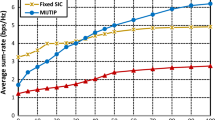Abstract
Incorporation of measurement based techniques in Worldwide Interoperability for Microwave Access (WiMAX) are required to improve IEEE 802.16 engineering methodologies. Wireless planning methodologies are presented, supported by a planning tool which facilitates the design and implementation of WiMAX networks. Propagation models available for WiMAX still need to be tuned and further validated. By comparing IEEE 802.16-2004 measurement results at 3.5 GHz with computed values using the modified Friis and the Stanford University Interim (SUI) models, for a suburban area, we found that the use of the modified Friis equation with a propagation exponent ~3 is more appropriate than the use of the SUI model, although, for coverage distances between 275 and 475 m, the SUI-B and mainly SUI-C models may still be used. From the analysis of the carrier-to-noise-plus-interference ratio, it is clear that both noise and interference present a strong limitation to the cellular reuse performance of fixed WiMAX mainly for higher order modulation and coding schemes. With a reuse pattern K = 7, cell throughputs near the maximum are only achieved in the uplink if sub-channelisation is used together with sectorization. The planning tool provides planners with practical and useful information through quick coverage/capacity based procedures, and outputs the number and position of the base stations and an estimation of the total cost of implementation, based on data provided by different equipment manufacturers. WiMAX cellular planning exercises are presented for the zone of Covilhã, Portugal, where Geographic Information Systems are used for representation of rural and sparse urban areas. One of the main conclusions is the strong need to use sector antennas in order to guarantee an adequate coverage, and higher system capacity whilst mitigating interference for several terrain types and environments, including hilly terrain.
Similar content being viewed by others
References
Liu H., Li G. (2005) OFDM-based broadband wireless networks—design and optimization. Wiley, Hoboken, New Jersey, USA
IEEE. (2009). IEEE standard for local and metropolitan area networks—part 16: Air interface for fixed broadband wireless access systems. New York, NY, USA: IEEE Std 802.16-2009 (Revision of IEEE Std 802.16-2004), IEEE.
IEEE. (2006). IEEE standard for local and metropolitan area networks—Part 16: Air interface for fixed and mobile broadband wireless access systems—amendment 2: Physical and medium access control layers for combined fixed and mobile operation in licensed bands and corrigendum 1. New York, NY, USA: IEEE Std 802.16e-2005 and IEEE Std 802.16-2004/Cor 1-2005 (Amendment and Corrigendum to IEEE Std 802.16-2004), IEEE.
Tomé, R., Lourenço, P., Grilo, A., Cercas, F. C., Rodrigues, A. J., Velez, F. J., et al. (2005). A WLAN planning tool with a practical approach. In Proceedings of International Symposium on Wireless Personal Multimedia Communications WPMC (Vol. 2, pp. 1286–1290). Denmark: Aalborg.
IEEE. (1999). Part II: Wireless LAN media access control (MAC) and physical layer (PHY) specifications. New York, NY, USA: IEEE Std 802.11-1999, IEEE.
Fragoso, J. G., & Tejada, G. M. G. (2005). Cell planning based on the WiMax standard for home access: A practical case. In Proceeding of 2nd ICEEE and XI CIE 2005 (pp. 89–92). Mexico.
Ibraihim, A. H., Ismail, M., Kiong, T., & Mastan, Z. (2005). Development of software planning tools for an-intelligent traffic light wireless communication link using 5.8 GHz WLAN. In Proceeding of 2005 Asia-Pacific Conference on Applied Electromagnetics (pp. 378–382). Malaysia: Johor.
Ruiz S., Samper Y., Pèrez J., Agusti R., Olmos J. (1998) Software tool for optimising indoor/outdoor coverage in a construction site. Electronics Letters 34(22): 2100–2101
Wertz P., Sauter M., Wölfle G., Hoppe R., & Landstorfer F. (2004). Automatic optimization algorithms for the planning of wireless local area networks. In Proceeding of VTC 2004-Fall, IEEE 60th Vehicular Technology Conference 2004-Fall-Wireless Technologies for Global Security (pp. 3010–3014). Los Angeles, CA, USA.
Anderson H. R. (2003) Fixed broadband wireless systems design. Wiley, Chichester, West Sussex, UK
Erceg V. et al (1999) An empirically based path loss model for wireless channels in suburban environments. IEEE Journal of Selected Areas in Communications 17(7): 1205–1211
IEEE 802.16 Working Group. (2001). Channels models for fixed wireless applications. Document 802.16.3c-01/29r4.
Hari, K. (2000). Interim channel models for G2 MMDS fixed wireless applications. Tampa, USA: IEEE 802 plenary meeting.
Wahl, R., Stäbler, O., & Wölfle, G. (2007). Propagation model and network simulator for stationary and nomadic WiMAX networks. In Proceeding of IEEE VTC 2007 Fall-IEEE 66th Vehicular Technology Conference. Baltimore, MD, USA.
Rappaport T. S. (2002) Wireless communications: Principles and practice. Prentice Hall, Upper Saddle River, NJ, USA
Moldkar, D. (1991). Review on radio propagation into and within buildings. In Proceeding of IEE Microwaves, Antennas and Propagation, (Vol. 138, No.1, pp. 61–73).
Panagopoulos A. D., Arapoglou P.-D. M., Kanellopoulos J. D., Cottis P. G. (2007) Intercell radio interference studies in broadband wireless access networks. IEEE Transactions on Vehicular Technology 56(1): 3–12
Sari H. (2001) A multimode CDMA with reduced intercell interference for broadband wireless networks. IEEE Journal on Selected Areas in Communications 19(7): 1316–1323
Bauer G., Bose R., Jakoby R. (2005) Three-dimensional interference investigations for LMDS networks using an urban database. IEEE Transactions on Antennas and Propagation 53(8): 2464–2470
Velez F. J., Correia L. M., Brázio J. M. (2001) Frequency reuse and system capacity in mobile broadband systems: Comparison between the 40 and 60 GHz bands. Wireless Personal Communications 19(1): 1–24
Velez, F. J., Carvalho, V., Santos, D., Marcos, R. P., Costa, R., Sebastião, P., et al. (2005). Planning of an IEEE 802.16e network for emergency and safety services. In Proceeding of 3G 2005-6th IEE International Conference on 3G Mobile Communication Technologies (pp. 507–511). London, UK.
Author information
Authors and Affiliations
Corresponding author
Rights and permissions
About this article
Cite this article
Sebastião, P., Velez, F.J., Costa, R. et al. Planning and Deployment of WiMAX Networks. Wireless Pers Commun 55, 305–323 (2010). https://doi.org/10.1007/s11277-009-9803-3
Received:
Accepted:
Published:
Issue Date:
DOI: https://doi.org/10.1007/s11277-009-9803-3




